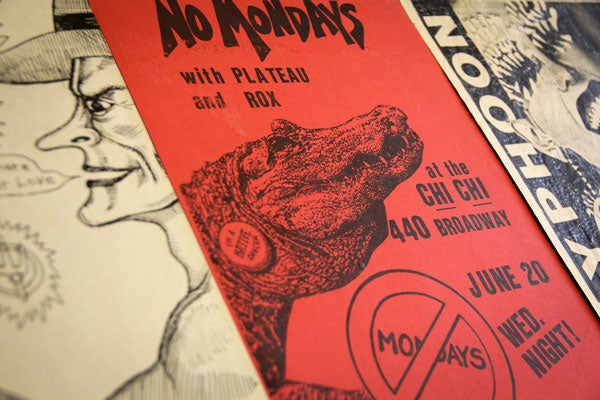|
August 21, 2014
Stanford library's punk poster art collection revives '80s musical history
Stanford's new archive of punk posters for legendary 1980s San Francisco bands offers a colorful and brash path of research for scholars from diverse fields. The size and comprehensiveness of the Tom Law Punk Poster collection is probably unmatched anywhere, library officials say. By Nate Sloan

Posters in Stanford's collection of punk rock art, housed in the Green Library, reflect the Bay Area's musical and cultural history of the 1970s and '80s. (Illustration: Veronica Marian)
The Stanford University Libraries host an impressive set of archival music collections ranging from 16th-century lute music to Dixieland jazz. Now, an unlikely cast of characters joins their ranks, as San Francisco punk stalwarts like Black Flag and the Dead Kennedys cozy up next to the likes of Jascha Heifetz on the library shelves.
Unlike most of the libraries' music holdings, however, this new collection does not consist of recordings or sheet music. Dead Kennedys singer Jello Biafra and company arrive at the Farm as part of the Tom Law San Francisco Bay Area Punk and Rock Handbill and Poster Collection. The massive array of 1,400 street posters advertising punk rock performances around the Bay Area from 1983-1986 is available in the Special Collections section at the Green Library.
"The size and comprehensiveness of the collection is probably unmatched anywhere," said Jerry McBride, Stanford's head music librarian.
As a result, it offers new insights into the climate of San Francisco in the early 1980s. The collection of "original posters of punk rock bands carefully removed and saved from street corners, rock club walls and bulletin boards," McBride said, provides "a time capsule of the period."
Street art, social rebellion
Endemic to punk's ethos was the desire to remain outside the music industry and mainstream channels. As such, most ads for shows were hand-drawn or collaged, printed on black-and-white, mimeographed 8.5x11-inch paper. These were stapled or taped to telephone poles, construction siding or any other available surface, and meant to last for a few days until the next set of posters were stapled over them.
Stanford music scholar Anna Schultz predicted that this new acquisition will appeal to a diverse group of researchers. She said it could attract "students and faculty interested in the histories of punk art, music and fashion working in art history, musicology, cultural studies, English and design."
The posters not only speak to the legendary San Francisco alternative music scene of the late 1970s and '80s, they illuminate the social and aesthetic spirit of artists during the era of President Ronald Reagan.
Impromptu and disposable, "this DIY (design-it-yourself) style of poster art exuded the immediacy of last-minute gigs and the thrill of social rebellion," Schultz said.
The collection as a whole is by turns funny, grotesque and politically engaged, and always eye-popping. Many of the posters are irreverent, like the one for the band The Naked Into, featuring a giant lizard cozying up to a '50s femme fatale.
Some of the posters have more political overtones, like the one from El Grupo Sexo, which includes a photo of then-President Reagan altered with the message "Beef Gives Strength."
Most of the clubs that the posters advertised are long gone and all but forgotten, but plenty of the bands represented have left an outsized impression on American music. In addition to local acts, burgeoning big-name bands like Sonic Youth, Primus, Diamanda Galas, Agent Orange and The Replacements are present in the Law collection.
'They caught my eye'
Neither a passionate punk devotee nor a visual art lover, Tom Law was a local classic-rock fan and heroin addict who reveled in aimless walks over the streets of San Francisco. While Law's own tastes tended more to the Rolling Stones and Dire Straits, he obsessively collected the punk posters, he said, based on one simple criteria: "They caught my eye."
On his frequent walks through the city he would carefully remove these posters with whatever he had on hand, whether a knife, key or piece of glass, and add them to his growing collection, stored pell-mell throughout his Tenderloin district apartment.
When he left San Francisco for Berlin in 1986 to enter a rehabilitation program, Law packed his posters into a trunk and brought them with him, where they remained, untouched, until his death in 2002. At the behest of Stanford music professors Schultz, Charles Kronengold and Mark Applebaum, and through the efforts of McBride, Stanford successfully bid to acquire the collection in the spring of 2014.
Whether ridiculous or subversive, hand-drawn or intricately collaged, the contents of the Tom Law collection are a direct lens into a heady musical moment in the Bay Area.
For McBride, "it documents this highly aggressive, frequently offensive and sometimes repulsive form of rock music and popular entertainment along with its alternative lifestyle and culture."
Punk in the classroom
Despite their hasty construction, the posters possess a high aesthetic quality. For example, many of the posters advertising performance by the seminal hardcore band Black Flag were designed by band bassist Raymond Pettibon, now a respected artist in his own right who is represented by top Manhattan galleries.
Stanford professors see the Tom Law Punk Poster collection as a boon to their teaching, as well as a site for in-depth research. Schultz said she considers the poster collection a "fantastic resource" for her course Music Ethnography of the Bay Area, which explores the varied musical cultures of the area.
For music professor Applebaum, the posters will make invaluable additions to his class Rock, Sex and Rebellion, both for lectures on the punk scene and for student term papers on 20th-century musical movements.
What's more, the collection will be housed in close proximity to its city of origin — as Kronengold said, "only a Caltrain ride away" — and will further bolster ties between Stanford's and San Francisco's common musical history.
Nate Sloan is a doctoral candidate in musicology and writes about the humanities at Stanford.
-30-
|